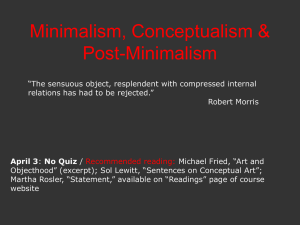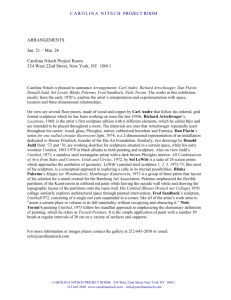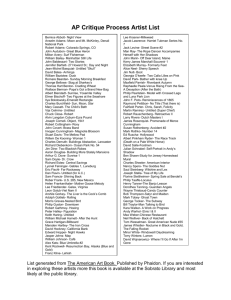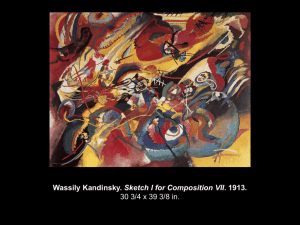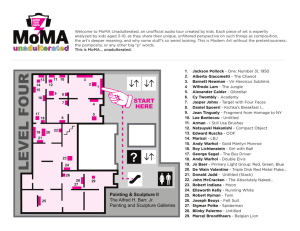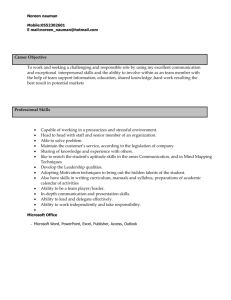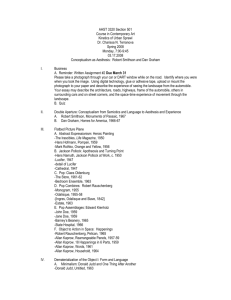Robert Morris, Installation at the Green Gallery, New York, 1963
advertisement
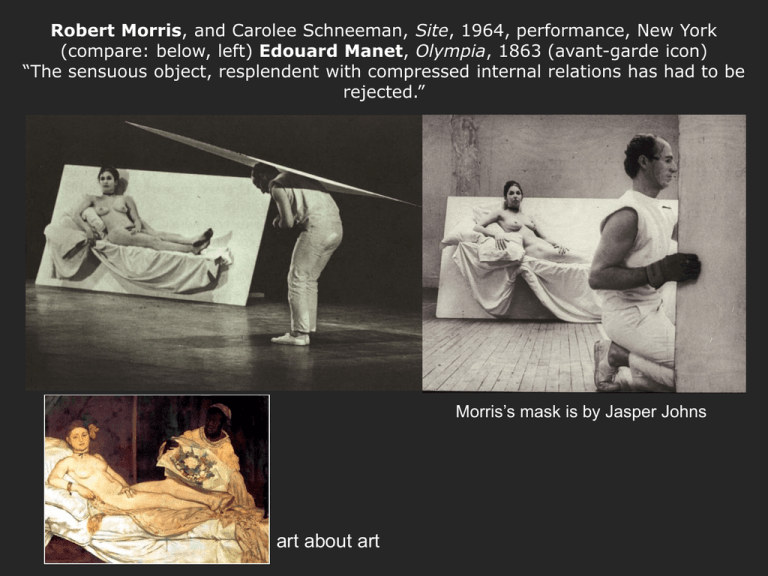
Robert Morris, and Carolee Schneeman, Site, 1964, performance, New York (compare: below, left) Edouard Manet, Olympia, 1863 (avant-garde icon) “The sensuous object, resplendent with compressed internal relations has had to be rejected.” Morris’s mask is by Jasper Johns art about art Robert Morris (US, b. 1931) Installation at the Green Gallery, New York, polyhedrons made from 2x4 wood painted gray, 1963 Morris theorized a “gestalt” all-at-once comprehension of the forms by the audience. Effective advent of Minimalism Robert Morris, (right) Untitled (Tangle) cut felt 1967, (left) Untitled, (Pink Felt) 1970, cut felt, dimensions vary with installation. Process Art – “anti-form” or “post-minimal” sculpture dependent upon gravity and chance, simple cutting process, use of “industrial” not-art material Industrial felt is arranged by chance for each installation. The artist’s supervision is not necessary. Robert Morris, (left) Poster for Sonnabend Gallery show, 1974 (right) I-Box, 1961 Neo-Dada, Duchampian mockery of Western modernism’s myths of the art’s masculinity, originality, individualist ego, and genius (right) Linda Benglis, Artforum ad, November 1974. This picture (a response to Robert Morris’s self-portrait ad, below), appeared in the front of the issue as an advertisement for Benglis’ show at the Paula Cooper Gallery. First wave Feminism Linda Benglis, Latex floor painting, 1969 Art in New York, says Benglis, is "all about territory," so there is only one pertinent question: "How big?" How big is the zone you capture and occupy with your painting, your floor sculpture, your video piece, your public persona? How powerful is the image that establishes your presence? Frank Stella (US, b. 1936) (right) Die Fahne Hoch, 1959 o/c. (below) compare Jasper Johns, Flag, 1956 (in 1958 Castelli show) Post-Abstract Expressionism, Minimalism Frank Stella, The Marriage of Reason and Squalor, II. 1959, enamel on canvas, 7' 7“ H “My painting is based on the fact that only what can be seen there is there. All I want anyone to get out of my paintings and all I ever get out of them is the fact that you can see the whole idea without any confusion. What you see is what you see.” - Stella Frank Stella (US b. 1936) Quathlamba, 1964, metallic powder in polymer emulsion, 6’5” x 13’7” Painting-sculptures to comprehend in a glance Formal sources for Minimalism (left) Barnett Newman with Cathedra, 1958 Abstract Expressionist “Sublime” (right) Kasimir Malevich, Russian Suprematism, White on White, o/c, 1918 Ad Reinhardt (US, 1907-1967), Painting, 1954-58, 78 x 78 in, Oil on canvas Source for Stella and Minimalism of 1960s Agnes Martin (Canadian-born American Minimalist Painter, 1912-2004) (left) Bones #2, 1959, Oil on canvas, 72 x 48 (right) Untitled, oil, ink & wash on canvas, 12” square,1961 Agnes Martin, The Dark River, (detail right) o/c, 75” square, 1961 Platonic idealism, meditative practice of “joy” Detail of The Dark River Humility, the beautiful daughter She cannot do either right or wrong She does not do anything All of her ways are empty Infinitely light and delicate She treads an even path. Sweet, smiling, uninterrupted, free. . . . Agnes Martin 1973 Photo of Martin in studio, 1973 Donald Judd (US, Minimalist sculptor, 1928-1994), (left) Untitled, cold rolled steel, 1964 (right top) Judd, Untitled, 1978-9 six brushed aluminum hollow rectangles set at 14-inch intervals (below right) Judd, Untitled, 1964, aluminum boxes Non-relational, “literal” objects A philosophy major at Columbia, Judd theorized his work in a 1965 essay, “Specific Objects,” as “non-relational” objects that supersede the traditions of painting and sculpture Theatricality and the “end” of Greenbergian modernism Sotheby installation: (at left), Donald Judd, Untitled, a stack of 10 stainless steel and red fluorescent plexiglass units stacked vertically in 9-inch intervals (detail on far left) (at right) Frank Stella, Nunca Pasa Nada, 1964, 110 x 220”, metallic powder in polymer emulsion on canvas detail Donald Judd, (left) artillery shed interior with permanent installation of 100 titled works, mill aluminum, (each) 41 x 51 x 72 in. The Chinati Foundation, Marfa, Texas Richard Serra, Splashing, 1968, molten lead left to harden, Leo Castelli warehouse. Action / Process Sculpture (left) Serra, One-Ton Prop, 1969; installation, 1969 of “prop” sculptures Serra, Tilted Arc, 12ft x 120 ft x 2.5 in, cor-ten steel, Federal Plaza, NYC, 1981-1989, Site-specific commissioned public artwork Document from legal battle to retain sculpture Federal Plaza before (above) and after (below) removal of Tilted Arc with planters and benches Maya Lin, Vietnam Veterans Memorial, polished black granite, 1982, Washington DC (below left) Frederick Hart, Vietnam Veterans Memorial, 1984 Fills minimalist form with new democratic memorial content that subverts the idealization of the lone warrior leader. Compare Washington obelisk, below right Richard Serra (left) Torqued Ellipses, cor-ten steel, 1997, Dia Foundation poster (right) Bilbao Guggenhein, 2005, A Matter of Time: a huge permanent installation of eight bent steel sculptures, possibly the largest installation to ever be housed in a museum gallery. The work is 1,200 tons and over 430 feet long in a 32,000 square foot gallery. Dan Graham, Urban Rooftop Project, Dia Foundation, Manhattan (closed), 2002 Composed of two-way mirror glass, and is therefore both translucent and transparent, reflective and opaque, depending upon the light. James Turrell (US, b. 1943) Spread, light installation, 2003 Los Angeles Light and Space Movement begun in the late 1960s Not “conceptual” but “perceptual” http://www.pbs.org/art21/artists/turrell/clip1.html# Robert Irwin (US, b. 1928), Untitled, acrylic disks and light, 1969 Los Angeles Light and Space Movement Irwin, 1234 Degree, openings cut out of windows, MCA San Diego, 1997 Carl Andre (American, b. 1935), 10 x 10 Altstadt Copper Square, Düsseldorf, 1967 copper, 100 units, 3/16 x 197 x 197 inches overall, Minimalism (right) compare influence: Frank Stella, Die Fahne Hoch, 1959, oil on canvas “non-relational” sculpture-painting Walking on an Andre sculpture at the Beaubourg, Paris, 2005 Carl Andre, (left) Twelve Copper Corner, 1975; (right) Seven Steel Row, 1975 Brancusi, (center) Endless Column, Tirgu Jiu Public Park, Rumania, 1938 “Brancusi is to me the great link into the earth and the Endless Column is, of course, the absolute culmination of that experience” (Carl Andre) Sol LeWitt (US, b.1928) Floor Structure Black, 1965, painted wood, 18 ½ x 18 x 82 in. “Ideas can be works of art; they are in a chain of development that may eventually find some form. All ideas need not be made physical.” “Paragraphs on Conceptual Art,” 1969 Minimal Art to Conceptual Art Sol Lewitt, Modular Open Cube Pieces (9 x 9 x 9) Floor/Corner 2 (Corner Piece), 1976 Lewitt, A Wall Divided Vertically into Fifteen Equal Parts, Each with a Different Line Direction and Color, and All Combinations 1970 "In conceptual art the idea or concept is the most important aspect of the work . . . all planning and decisions are made beforehand and the execution is a perfunctory affair. The idea becomes the machine that makes the art." Sol LeWitt: "Paragraphs on Conceptual Art," Artforum, summer issue, 1967 Lewitt, Wall Drawing #146, September 1972. All two-part combinations of blue arcs from corners and sides and blue straight, not straight, and broken lines; blue crayon, Dimensions vary with installation. Sol LeWitt, Wall Drawing No. 681 C / A, 1993 Instructions: wall divided vertically into four equal squares separated and bordered by black bands. Within each square, bands in one of four directions, each with color ink washes superimposed, colored ink washes, (120 x 444 in.) Vito Acconci, Following Piece documentation, installed in 1969 at Barbara Gladstone Gallery, NYC, black and white photographs with text and chalk, text on index cards. Concept: Follow a different person every day until person enters private place. “I was a passive receiver of someone’s time and space.” (Acconci) Conceptual art “Can an artistic intervention truly bring about an unforeseen way of thinking? Can an absurd act provoke a transgression that makes you abandon the standard assumptions on the sources of conflict? Can those kinds of artistic acts bring about the possibility of change?” - Francis Alÿs 2005 Art in the age of doubt = post-avant-garde (Do you still believe that art change things?) Francis Alÿs (Belgian, lives in Mexico City, b. 1959), photographs of a 1995 project in which he painted a green line along an armistice boundary originally drawn on a map in green grease pencil by the Israeli leader Moshe Dayan in 1948. "For the moment, I am exploring the following axiom: Sometimes doing something poetic can become political and sometimes doing something political can become poetic." Map showing the real Green Line and the politics of Alÿs’ poetic (aesthetic) artwork, Green Line The faint green dotted line (the 'Green Line') represents the armistice line established after the 1948 Arab-Israeli War. Land to the right of the line was taken by Israel in 1967, and is still occupied today. The purple blobs on the map are new Israeli settlements - Jews only built up since 1967 on occupied land - The orange line is the line of wall under construction by Israel. Francis Alÿs on his walk through Jerusalem in 2005, in which he retraced the Green Line with a leaky paint can. Video still. “Poetic license functions like a hiatus in the atrophy of a social, political, military or economic crisis. Through the gratuity or the absurdity of the poetic act, art provokes a moment of suspension of meaning, a brief sensation of senselessness that reveals the absurdity of the situation. . . .” - Alÿs For more information about Alÿs, see Artforum essay: http://www.encyclopedia.com/do c/1G1-145872683.html Joseph Kosuth (US, b. 1945) One and Three Chairs, installation, 1965 Conceptualism Kosuth, One and Three Tables, 1965, Installation, wooden table, gelatin silver photograph, and photostat mounted on foamcore Hans Haacke (German, b.1936), Shapolsky et al. Manhattan Real Estate Holdings, a Real-Time System, as of May 1, 1971, 1971: 142 photographs of New York apartment buildings, 2 maps of New York's Lower East Side and Harlem with properties marked, 6 charts documenting business relations within the real estate group. Bernhard and Hilla Becher (German, born 1931 and 1934 respectively) Conceptual (typological) photography (left) Gas Tanks, 1963 (right) Water Towers, 1980, 9 b/w photographs mounted on board, 62inH overall Cildo Meireles (Brazil, 1948) in the early ’70s Cildo Meireles, Insertions into ideological Circuits: Bank Note Project (Who Killed Herzog?) 1970, rubber stamp and bank note Cildo Meireles, Insertions into ideological Circuits:1. Coca-Cola Project, 1970 printed stickers on Coca-Cola bottles, dimensions variable, collection the artist Bruce Nauman (US 1941) (left) Eating My Words, and (right) Self Portrait as a Water Fountain, from Eleven Color Photographs" (1966-1967/70) “If I was an artist and I was in the studio, then whatever I was doing in the studio must be art. At this point art became more of an activity and less of a product.” Bruce Nauman (US 1941) (left) Wax Impressions of the Knees of Five Famous Artists, 1966, fiberglass and polyester resin, 15 5/8 in. x 85 1/4 in. x 2 3/4 in. Collection SFMOMA (right) Hand to Mouth, wax over cloth, 1967 (cast from wife’s body) "If they're not puzzled, they're not getting it." - Robert Storr (MoMA NYC) on Nauman’s viewers Nauman, Art Makeup, White, Black, Pink, Green, 1967-8, performance video stills Nauman, Slow Angle Walk (Beckett Walk) (1968). Video, 60 min My name as though it were written on the surface of the moon. Bruce Nauman, The True Artist Helps the World by Revealing Mystic Truths (Window or Wall Sign), 1967. Neon tubing with clear glass tubing suspension supports; 59 X 55 x 2 in Original made for the artist’s San Francisco street-front studio window: the private thought made as public as a commercial beer sign. Conceptual art is a poetic intervention into conventional (unquestioning) modes of “thought.” "The most difficult thing about the whole piece for me was the statement. It was a kind of test - like when you say something out loud to see if you believe it. Once written down, I could see that the statement [...] was on the one hand a totally silly idea and yet, on the other hand, I believed it. It's true and not true at the same time. It depends on how you interpret it and how seriously you take yourself. For me it's still a very strong thought." - Nauman Nauman, South American Triangle, 1981, welded steel beams (each 165” long) and cast iron chair. Inspired by Jacobo Timerman’s account of his torture by the Argentinean military regime. Bruce Nauman, Hanging Carousel (George Skins a Fox), 1988, taxidermist forms and suspension of South American Triangle signify victimization and violence. http://www.pbs.org/art21/artists/nauman/clip2.html# Eva Hesse (American born Germany,1936-1970, 34 years), Metronomic Irregularity, 1966. Post-Minimalism Hesse, notebook page, 1965-66; Hang Up, acrylic on wood, cloth, steel, 1966 Hesse in New York apartment holding Ingeminate, 1966; Hesse Ingeminate 1965, surgical hose, papier-mâché, cord and sprayed enamel over balloons (detail) Eva Hesse (left) Accession II 1967 galvanized steel, rubber tubing, c. 30”square Hesse with Accession II in 1968 Hesse, Sans II (two views),1968 fiberglass polyester resin 5 units, each 38inH detail Compare Minimalist sculpture of Donald Judd, Untitled, 1964 Hesse, Repetition Nineteen III, fiberglass and polyester resin, 1968 Hesse, 1970. Fiberglass over polyethylene over aluminum wire. 7 units each 78 in. x 40 in. Berkeley: University Art Museum Hesse, Rope Piece, 1979 “I remember I wanted to get to non art, non connotive [sic], non anthropomorphic, non geometric, non, nothing. . . . question how and why in putting it together? Can it be different each time? Why not? How to achieve by not Making? Compare Eva Hesse, 1969, with Marcel Duchamp, Sixteen Miles of String, 1942, part of Duchamp’s installation for the First Papers of Surrealism, Peggy Guggenheim’s Art of this Century gallery, NYC Tara Donovan (American, 1969) Untitled (Plastic cups), 2006, millions of transparent plastic cups in a tight grid, stacked into curves and waves. (The work is re-made each time it is shown and can be expanded or contracted to fit the space.) Tara Donovan, Untitled (Plastic Cups) 2000 installation Tara Donovan, Untitled (Glass), 2006. Sheets of stacked tempered glass; one corner of each pane is struck with a hammer and shattered into tiny pieces that stay in place. “If you bump into this and knock a corner off it, it can’t be repaired or remade with the same materials. It has to be made over again.” When the show is over, "it gets taken away with a shovel.” Tara Donovan, Untitled (Styrofoam cups), 2006 installation
